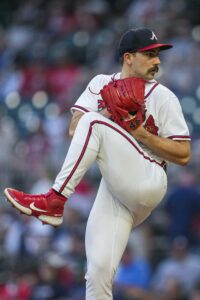Former All-Star Edwin Jackson took to Instagram this evening to officially announce his retirement from Major League Baseball. The right-hander pitched parts of 17 seasons in the majors, getting to the highest level every year between 2003-19. Jackson suited up for 14 different MLB teams, setting the all-time record for most uniforms donned.
“19 years ago today I was blessed with an opportunity to tie up my laces and step on the field to make my debut with the Los Angeles Dodgers,” Jackson wrote. “Today I am happily hanging up my cleats and closing a 22-year baseball career.” Jackson went on to thank his wife, parents, sisters, children and the rest of his family before expressing his gratitude to various coaches, trainers and doctors who assisted him. “This game has taught me many life lessons and allowed me to evolve into the person I am today! I will forever have memories that will live within me from the game I love and dedicated my life to. Thank you baseball for an amazing life experience I will never forget,” he concluded.
A sixth-round draftee of the Dodgers out of a Georgia high school in 2001, Jackson emerged as one of the sport’s best pitching prospects not long thereafter. He broke into the big leagues exactly 19 years ago on his 20th birthday, starting three of four appearances down the stretch. He bounced on and off Los Angeles’ active roster for the next couple seasons before being traded to the then-Devil Rays over the 2005-06 offseason.
Jackson worked primarily as a reliever for his first season in Tampa Bay, but he took a full turn of starts by the 2007 campaign. That kicked off a stretch of seven consecutive seasons in which he surpassed 30 starts and 160 innings. Jackson pitched in Tampa Bay through 2008 before being dealt to the Tigers for outfielder Matt Joyce. He tossed a career-best 214 innings the next year, posting a 3.62 ERA. Jackson earned an All-Star nod with a 2.52 mark through that season’s first half.
The next offseason, his nomadic career continued. Detroit flipped Jackson to the Diamondbacks as part of a three-team blockbuster that netted Detroit Max Scherzer and sent Curtis Granderson to the Yankees. His stint in the desert was rather brief — he’d wind up traded again at that summer’s deadline — but it provided one of the more memorable moments of his career. On June 25, 2010, he tossed a no-hitter against his former team at Tropicana Field. He threw a staggering 149 pitches in the outing, striking out six but issuing eight walks. Then-manager A.J. Hinch stuck with Jackson despite his high pitch count, and he completed one of the more remarkable single-game performances by a player in recent memory.
Not long after, the last-place club dealt Jackson to the White Sox in a trade that landed Arizona Daniel Hudson. Jackson pitched well in 11 starts down the stretch, and he got off to another solid start in 2011. The White Sox fell out of contention the latter season, though, and he was on the move again. The Blue Jays acquired Jackson from the White Sox on the morning of July 27, but his stint in Toronto lasted only a few hours. Toronto promptly flipped him to the Cardinals in a deal that sent Colby Rasmus north of the border.
Jackson played in St. Louis for the second half, pitching to a 3.58 ERA through 12 starts. He made four starts in the postseason, and while his playoff numbers weren’t great, the Cardinals secured the World Series title in a dramatic series win over the Rangers. Fresh off winning a title, Jackson signed with the Nationals during his first trip through free agency. He spent the 2012 campaign in the Nats rotation, helping Washington to their first playoff appearance since moving to D.C.
The next winter, Jackson inked a four-year, $52MM pact with the Cubs. He continued to soak up innings but didn’t post especially strong numbers in Chicago. After two and a half seasons, he was released. That kicked off an even more rapid trip around the league, as Jackson suited up with the Braves, Marlins, Padres, Orioles, Nationals (again), A’s, Blue Jays and Tigers (again) over the next four years. He alternated between the rotation and the bullpen throughout that time, generally serving as a depth option.
While Jackson signed a minor league deal with the Diamondbacks in 2020, he didn’t make it back to the majors. He did appear on the U.S. Olympic team last summer and expressed a desire to get back to the big leagues, but he didn’t get another opportunity with an affiliated organization.
Altogether, Jackson pitched in 412 major league games. He tossed 1960 innings with a 4.78 ERA, striking out a bit more than 1500 batters and winning 107 games. According to Baseball Reference, Jackson banked upwards of $66MM in earnings and incredibly logged some action for almost half the league. MLBTR congratulates Jackson on his lengthy, accomplished career and wishes him all the best in retirement.

